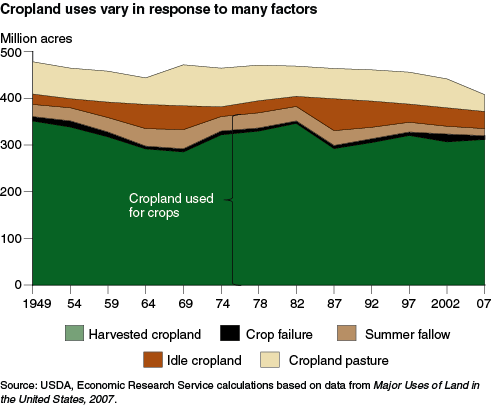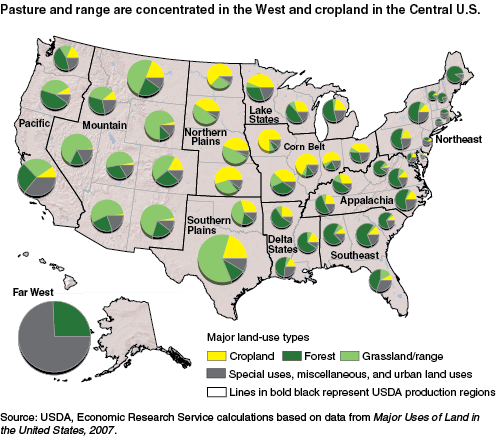How Is Land in the United States Used? A Focus on Agricultural Land
- by Cynthia Nickerson and Allison Borchers
- 3/1/2012
How land is used and changes in land use have implications for commodity production and trade, soil and water conservation, bioenergy supply, climate change adaptation, and many other policy issues. A complex set of factors, including commodity prices; production technology; demand for land for residential, commercial, and industrial development; and agricultural and bioenergy policies, can induce land-use change as landowners respond to market conditions and try to maximize the returns to their land.
For over 50 years and in roughly 5-year intervals, ERS has synthesized data from a variety of Federal and other sources to develop national and State estimates of land in various uses, including cropland, pasture and range, and forest. These data are used to develop a consistent set of national estimates that provide insights into how land uses change over time. The ERS Major Land Uses series is the longest running accounting of all major uses of public and private land in all 50 States.
U.S. land area covers nearly 2.3 billion acres. The proportion of the land base in agricultural uses has declined from 63 percent in 1949 to 51 percent in 2007. Gradual declines have occurred in cropland and pasture and range, while grazed forestland has decreased more rapidly.
In 2007, 408 million acres of agricultural land were in cropland (down 17 percent from 1949), 614 million acres were in pasture and range (down 3 percent), 127 million acres were in grazed forestland (down 52 percent), and 12 million acres were in farmsteads and farm roads (down 19 percent). Nonagricultural uses have increased from 37 to 49 percent of the land base, largely due to a fourfold increase in National Parks and National Wilderness/Wildlife areas, particularly in Alaska.
Market forces, changes in farm programs, and changes in technology affect the supply and demand for land used for crop production. Between 1949 and 1969, cropland used for crops decreased by 54 million acres and then peaked at 383 million acres in 1982, when no cropland was diverted through Government-acreage reduction programs. Since 1980, cropland used for crops has been relatively stable, despite significant variation in commodity prices (see 'Commodity Prices Vary More Than U.S. Cropland Acreage').
Relatively stable patterns of changes in land use at the national level obscure larger shifts in land use at regional and State levels. For example, between 1964 and 2007, cropland used for crops-the acreage devoted to crop production in any year, including cropland harvested, land on which crops failed, and cultivated summer fallow-increased by 11 million acres in the Corn Belt and decreased by a net 11 million acres in the remaining regions. Both the Northeast and Southeast experienced a long-term decline in cropland used for crops. Urban pressures and a comparative disadvantage in many crops resulted in the conversion of cropland to other uses in these regions.
Regional land-use patterns vary with differences in soil, climate, topography, and population. Cropland is roughly concentrated in the central regions of the contiguous United States; pasture and range in the more arid West; and forest land (both grazed and not grazed) in the East, where the topography and precipitation patterns are conducive to growing trees. The Northeast and Southeast have the highest shares of urban land, while 80 percent of the total acreage in parks, recreation, and wildlife uses are in the Mountain and Pacific regions and in Alaska.
Grazing lands generally are less suited for crop production than for other uses. Substantial acreage used for grazing has shifted to recreational, wildlife, and environmental uses. Under favorable growing conditions, particularly in the South, pasture land may revert to forest. Some acres are converted to urban uses to serve the needs of a growing population. These factors have combined to cause a long-term net decline in grazing acreage, from over 1 billion acres in 1949 to 741 million acres in 2007.
Every year, some rural land is converted to developed uses. Once converted, these lands rarely revert to rural uses. Over the past several decades, most land that converted to developed uses was previously in an agricultural use. Although only 3 percent of the land base, urban areas-which are defined by the Census Bureau as densely populated areas with at least 2,500 people-increased to 61 million acres by 2007. The amount of developed land outside of urban areas is more difficult to estimate. Residential uses-one type of developed land occurring outside developed areas-is estimated at an additional 103 million acres; these lands are included in the MLU 'other land' category. Land in rural transportation, defense, and industrial uses is estimated at nearly 50 million acres, which are included in the MLU 'special uses' category. Together, about 214 million acres, or 9 percent of the land base, are in urban areas or in developed uses outside urban areas.
You may also like:
- Major Land Uses. (n.d.). U.S. Department of Agriculture, Economic Research Service.




